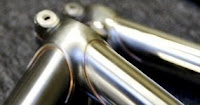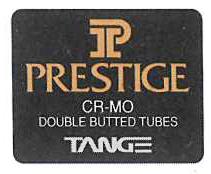In doing so, I questioned the usual suspects, and quickly came to a decision - late 80s Japanese steel road frames are overlooked. They are very well made, of good quality Tange tubing, and often disguised under a mass market brand that's not "cool".
The retro fixie crowd has generated a huge amount of hype for anything old, Italian, lugged and made of Columbus tubing. English Reynolds is not so highly regarded, even though their later tubesets were quite advanced (and race wins frequent).
In the late 80s, due to the boom in MTB manufacture in Japan and Taiwan (and small frame builder demand in the US), Tange of Japan began building tubesets that in many cases bettered what the Europeans made.
By the early 90s, the worlds premium MTB brands were all using Tange tubing, often rebadged with their own names, or made by Tange to their specifications.
Ritchey, Ibis, Fat Chance, Scott, GT, Nishiki and many others were building their highest end frames with Tange Prestige tubing. Tange's premium tubing line was seamless tube, cold drawn, butted (thinner in the middle), and heat treated (building greater strength around the weld areas).
At one stage, even Colnago was using Tange Ultimate Superlight (oversized Prestige) in their premium "Master-Light". It certainly didn't say that on the seat tube decal!
Tange's manufacturing flexibility and relationships with US brands meant that a wide range of tubing diameters and thicknesses were available for builders, to ensure that models could be size, weight, usage and price specific. For example, Tange Infinity was a tubeset with similar weight and strength to Columbus SL or Reynolds 531, but it differed in that it was a rolled tube with a seam. This meant it was far cheaper to manufacture than drawn seamless tubing. This did not effect the ride characteristics which were identical to it's European cousins.
Additionally, the Japanese bike building factories were making frames of a similar quality to those of Europe, and in most cases far superior at the mid level price point. I'd rather an 80's Nishiki over a similarly priced Gitane or Peugeot!
However, by the early/mid 90s, the Yen was stronger, and the Japanese factories less competitive. Taiwan was favoured because it was cheaper, and they had invested wisely in Aluminium construction techniques (the "next big thing"). By the late 90s all the bike manufacturing plants in Japan had closed, with the only manufacture being specific small production runs for local sales and Keirin racing.
 Tange closed it's doors in the US and Europe by the end of last century, and by the end of 2003, the Taiwan office as well.
Tange closed it's doors in the US and Europe by the end of last century, and by the end of 2003, the Taiwan office as well.Tange opened the office in the US again in 2008, and tubing demand is strong.

